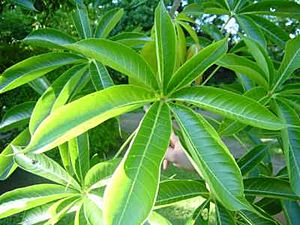Sterculia foetida facts for kids
Quick facts for kids Sterculia foetida |
|
|---|---|
 |
|
| Scientific classification | |
| Genus: |
Sterculia
|
| Species: |
foetida
|
| Synonyms | |
|
|
Sterculia foetida is a tall tree with soft wood that can grow up to 35 meters (about 115 feet) high. It was first described in 1753 by a famous scientist named Carl Linnaeus. This tree has many interesting common names like the java olive tree, wild almond tree, and even the skunk tree. The name Sterculia comes from an old Roman god, Sterquilinus, who was linked to fertilizer or manure. This gives you a hint about one of the tree's special features!
Contents
What the Tree Looks Like
The branches of the Sterculia foetida tree grow in circles, spreading out wide. The tree's bark is smooth and grey. Its leaves grow at the end of small branches. Each leaf has a long stem, about 125–230 mm (5-9 inches) long. The leaves are shaped like a hand with 7 to 9 smaller leaf parts, called leaflets. These leaflets are oval-shaped and about 100–170 mm (4-7 inches) long. The stems of the leaves are actually where the tree gets its strong, unpleasant smell.
Flowers and Fruit
The flowers grow in clusters that are 100–150 mm (4-6 inches) long. These flowers can be green or purple and are quite large. The tree has separate male and female flowers, meaning male flowers are on one tree and female flowers are on another. This is called being dioecious. The pollen from the male flowers is oval-shaped and very tiny. The outer part of the flower, called the calyx, is a dull orange color. It is divided into five parts, each about 10-13 mm long.
After the flowers, the tree produces fruit. The fruit is made of four to five pods, called follicles. Each pod usually holds 10 to 15 seeds. When the pods are ready, they turn a bright scarlet red.
In India, the flowers usually appear in March, and new leaves grow between March and April. In some places, like Hyderabad, India, flowering has been seen in September and October, with ripe fruits appearing about 11 months later in February.
Uses of the Tree
The oil from Sterculia foetida seeds has been studied for use as a biofuel. Biofuels are fuels made from plants or animals, like the ones used in cars. This oil has properties similar to oils from sunflowers, soybeans, and grapeseeds, which are also used for fuel. Scientists check many things about the oil, like how easily it burns and how thick it is, to make sure it meets safety and quality standards for fuel.
The seeds of Sterculia foetida can be eaten, but they must be roasted first. Eating them raw might cause an upset stomach. Some research suggests that certain fats in the seeds, if eaten raw, might not be good for human health. So, it's important to be careful and make sure they are prepared correctly.
Where the Tree Grows
Sterculia foetida can be found in many parts of the world. It grows in countries like India, Taiwan, Philippines (where it's called kalumpang), Indonesia, Ghana, Australia, Mozambique, and Togo. It can also be found in Hawaii in the United States.
Gallery
See also
 In Spanish: Sterculia foetida para niños
In Spanish: Sterculia foetida para niños




